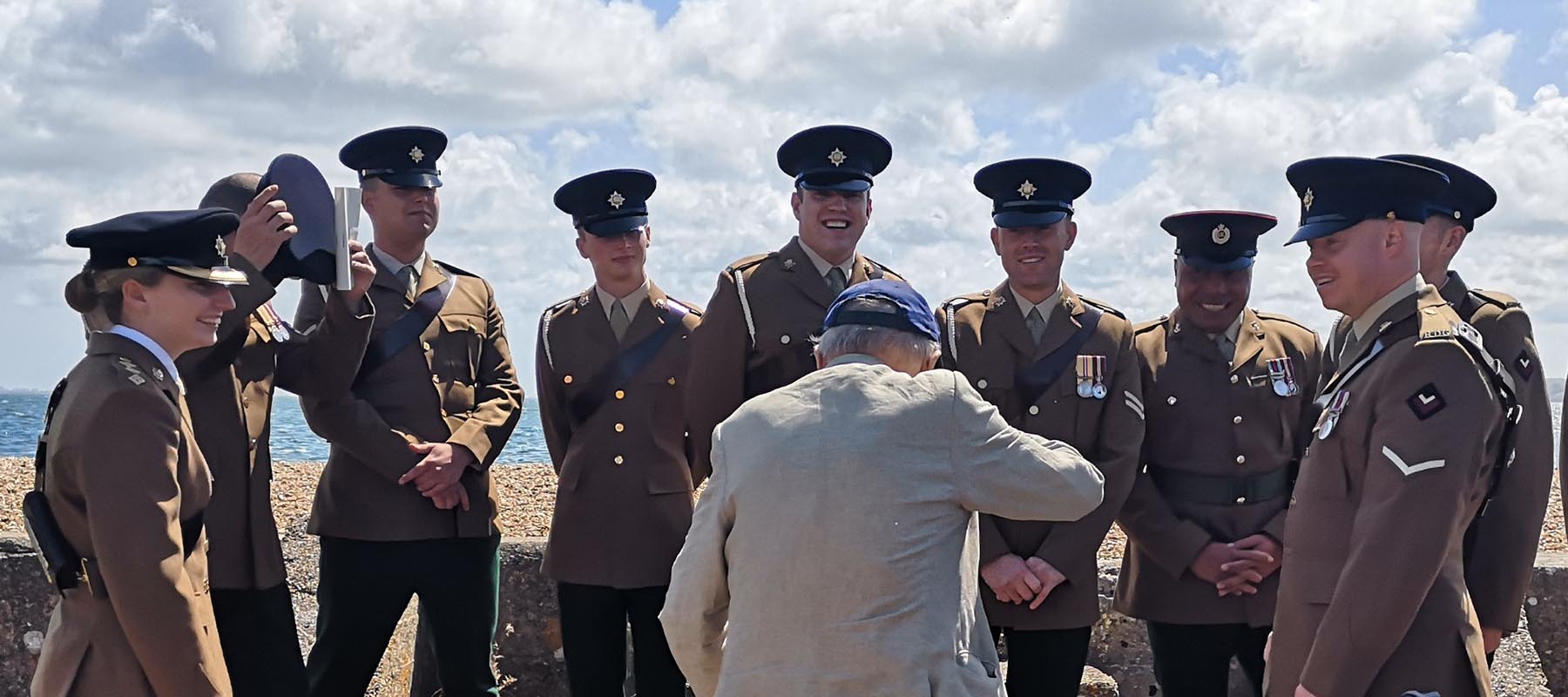
Dr Phil Marter, Senior Lecturer in Archaeology and an expert in battlefield archaeology, writes about a moving tribute made as part of D-Day 75 and marking the men of the 4th/7th Royal Dragoon Guards who took part in the historic D-Day landings 75 years ago.
By the shore at the far end of Stanswood Bay in the New Forest National Park, stands a large solid looking obelisk. Its polished surface carries a commemorative plaque and it is set onto a large block of concrete. Around this monument can be seen familiar crosses of remembrance. This year they are marked with 'D-Day 75'. The concrete base was built in 1943 as part of a huge Pheonix Caisson construction site in Stanswood Bay, located at the end of Lepe Beach. The site was one of a number around the Solent responsible for making elements of the great Mulberry Harbour that would be assembled off the coast of Arromanche in the days following the Normandy Landings.
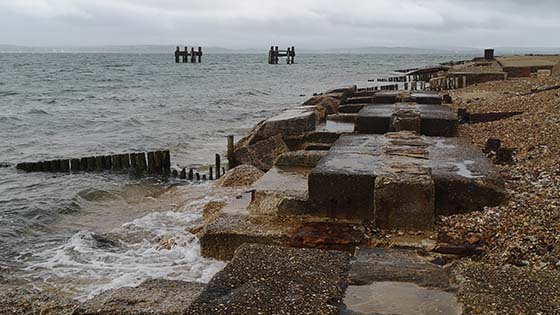
Photo: the Pheonix Caisson construction site at Stanswood Bay with Embarkation Hard Q2, where Cecil Newton and the 4th/7th Royal Dragoon Guards left for D-Day, in the background.
The obelisk is part of the construction site now, but clearly not of it. The text inscribed into its surface reads: 'Take these men for your example. Like them remember that prosperity can only be for the free, that freedom is the sure possession of those alone who have the courage to defend it.'
These words, attributed to Pericles nearly 2,500 years ago, in their new context, refer to the men of the 4th/7th Royal Dragoon Guards. The monument they are inscribed into commemorates those from the regiment killed in the Normandy campaign.
Today, a group of people, some in uniform and some in smart dress, others in coats and warm hats, have gathered around the obelisk. They are focused on one man, who stands leaning against its concrete base.
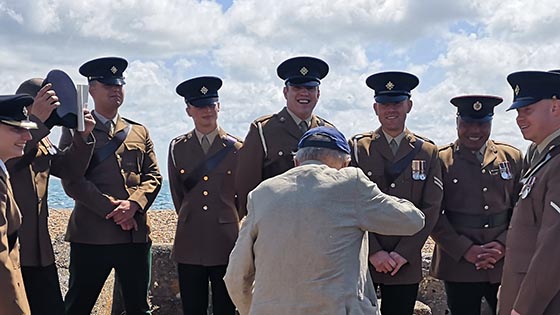
Photo: Cecil with members of the Royal Dragoon Guards at the Stanswood Bay memorial on 3 June 2019.
Leaning against a memorial like this might be seen by some as a disrespectful act, but this man leans not out of a lack of consideration or respect, but out of belonging. At 97, Cecil Newton does well to stand unaided on the uneven surface surrounding the structure. He leans to steady his balance, but also out of affinity and care, out of kinship for those the monument commemorates. Cecil was there. The names on this monument are those of his friends and comrades, and he has played a central part in its dedication.
In the minutes that follow, he proceeds to tell a tightly huddled and enthralled gathering about his D-Day experience and how his unit left from the embarkation point just behind where we were gathered, on this day 75 years ago. He describes the time between their embarkation on 3 June and the night of 5 June 1944, when the men were forced to await the start of the invasion on their landing craft. They suffered rough seas at anchorage in the Solent as D-Day was postponed until 6 June. He describes how the Duplex Drive Sherman Tanks, designed for amphibious beach assaults, rolled down the ramps of their LCT (Landing Craft Tank) into the cold waters of Gold Beach King Green sector in the 'thundering dawn' of D-Day.
His tank had stood off in the shallows and engaged an enemy block-house whose occupants soon surrendered. He described the scenes of battle around him and their gradual progress in-land. Cecil and the 4th/7th Royal Dragoon Guards went ashore at H -5, that is five minutes before the main assault force. The regiment was to end the day 8km inland, liberating the small town of Creully.
By the end of the campaign, 124 men from the regiment had been killed. Many had joined with Cecil and some had been close friends. They had fought their way from Gold Beach, through Normandy, across the Seine, to Nijmegan (with Operation Market Garden) and to the area around Arnhem. It was here, during an attack on Tripsrath that Cecil was badly wounded when his tank was hit and he was shot in the back as he tried to escape the stricken vehicle. It was remarkable that he had survived. It was a heartfelt and modest account that focused on his friends.
Once his story was finished, he led a prayer for those that had lost their lives and then produced a cassette recorder from behind him, pressed play and the sound of 'The Last Post' rang out over the gathering. Amid the salutes of current serving Royal Dragoon Guards, Cecil stood silently remembering. 'Remembrance' by somebody who was there is a particularly moving thing to witness. In discussion afterwards it was clear his over-riding purpose now was to ensure nobody would forget and that others would take up the task when he'd gone.
I had heard from the Royal Dragoon Guards regimental secretary that the regiment also had a memorial in Creully, Normandy. Two memorials, one on a windswept beach on the Solent and one in Normandy. One at the start of the 4th/7th Royal Dragoon Guards' D-Day experience and one at the end.
So often our historic battles occur on a single field, but this great D-Day battle was something different. Between 3 and 6 June 1944, Operation Overlord and its seaborne element Operation Neptune, delivered the largest amphibious assault the world has ever seen. More than 156,000 men and their equipment were transported from England to Normandy to open a second front designed to bring about the defeat of Nazi Germany. This enterprise unleashed a battle that began on the south coast of England and continued across the Channel and onto the assault beaches of Normandy.
To mark the experience of Cecil's Regiment and their D-Day journey, I set out to deliver a modest and symbolic tribute from both his beach embarkation point and his assault beach arrival point; to the respective monuments in Stanswood Bay and Creully.
Sand from Stanswood Bay was placed into especially commissioned pots, made by local potter Suna Imre, one fired, to be placed onto the memorial in Cruelly and the other unfired, to be placed into the water on Gold Beach. In return, sand from Gold Beach would be gathered and put into an unfired pot for placing into the water at Stanswood Bay and some also into a fired pot to be placed onto the memorial where Cecil had led our service.
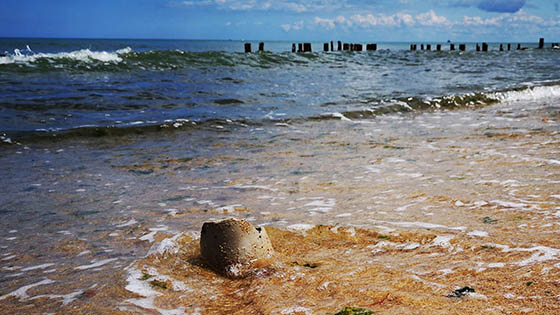
Photo: Commemorative pot containing sand from Stanswood Bay, placed on Gold Beach, King Green Sector on 6 June 2019.
After attending the service at Stanswood Bay with Cecil on 3 June, I travelled overnight on 5 June to Normandy. It was hard not to wonder what thoughts would have filled the minds of soldiers making the same journey 75 years before.
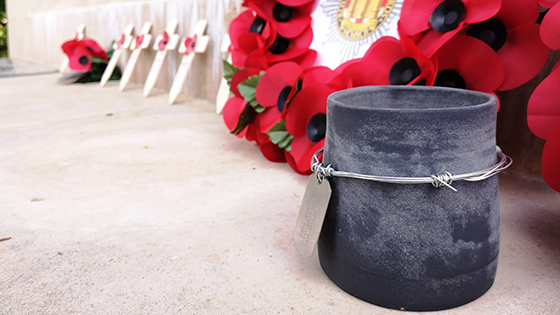
Photo: Commemorative pot containing sand from Stanswood Bay, placed on the regimental memorial in Creully (the last town liberated by the regiment on D-Day), on 6 June 2019.
Early the next day, I arrived at the regimental monument in Creully to place the pot with sand from Stanswood Bay. A crowd marched from the town centre to the memorial, led by regimental veterans and the sound of bagpipes. Cecil took centre stage once more as the wreaths were laid and school children read the names of the 124 members of the regiment who had lost their lives.
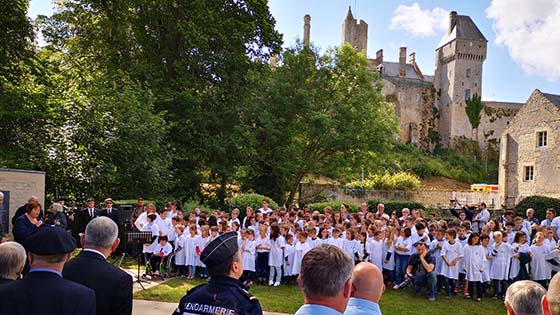
Photo: The service at Creully, in the shadow of the castle where Richard Dimbleby made some of the first BBC broadcasts from the front in June 1944.
This monument in the heart of Creully now belonged to the children and their town and formed part of the story of the place they lived. It was also clear that Cecil was their man. Under the watchful gaze of the ancient castle, in the sunshine and to the sound of school children singing national anthems with regimental veterans, it is hard not to feel optimistic about Cecil's mission.
Below the inscription on the obelisk at Stanswood Bay is the 4th/7th Royal Dragoon Guards plaque. Its final words are the regiment's motto: 'Quis Separabit' - 'Who shall separate us?' How appropriate. Two places, two monuments in two different countries, linked by one battle, one regiment's journey and one man's story. An unbreakable bond of courage and sacrifice. It seems Cecil has done his duty and these places will forever be the guardians of the 4th/7th Royal Dragoon Guards' remarkable story.
As the years go by and veterans like Cecil gradually pass from our company, the importance of these monuments and traditions will grow. The torch is being passed. I hope we are all ready to take up the challenge.
These pots are symbolic of the lasting link between the site that the 4th/7th Royal Dragoon Guards departed from at Stanswood Bay and the assault beaches where they went ashore in Normandy. The sand contained within each represents the sacrifice of those whose lives were lost in the pursuit of freedom. The regimental motto 'Quis Separabit' ('Who shall separate us'), is inscribed on the tag of the Creully pot. This reminds us of the indelible bond between those who served the regiment so faithfully and the lasting link created between places on the shores of both England and Normandy and the towns they liberated all those years ago. 'In Remembrance'
Press Office | +44 (0) 1962 827678 | press@winchester.ac.uk | www.twitter.com/_UoWNews
Back to media centre